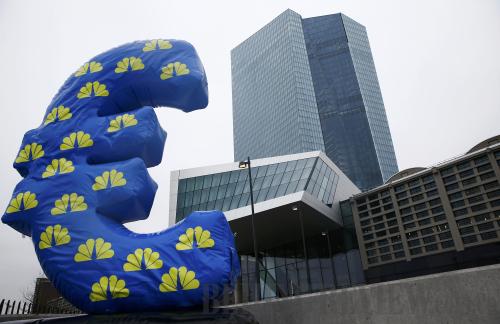|
 |
|
CHEAPER EURO: An inflated euro sign asserts its dominance outside the new headquarters of the European Central Bank (ECB) in Frankfurt. The ECB announces a 1-trillion-euro plan to buy government bonds, causing the euro to fall sharply (CFP) |
Finally the European Central Bank (ECB) decided to follow the decision of Federal Reserve (Fed) to print money massively. It is uncertain whether the eurozone can brace powerful recovery, just as the United States did after quantitative easing (QE), but far away in China, the yuan has been affected.
Mario Draghi, President of the ECB, announced on January 22 that the ECB would launch an expanded asset purchase program. Under this program, the combined monthly purchases of public and private sector securities will amount to 60 billion euros ($68 billion). The program will most likely be in effect until the end of September 2016 and will in any case be conducted until the inflation rate is close to 2 percent over the medium term. This means that, altogether, there will be nearly 1 trillion euros ($1.13 trillion) in the market.
The euro fell sharply after the ECB unveiled such a big QE program, falling to an 11-year low of $1.13 on January 22. Driven up by the eurozone's QE, the central parity rate of the yuan strengthened by 1,409 basis points to 6.9795 against the euro on January 23, the biggest daily rise since November 2011 and lower than 7 yuan for the first time in history, according to figures from the China Foreign Exchange Trading System.
The launch of QE by the ECB, together with the U.S. normalizing its monetary policy, will lead to a stronger U.S. dollar, which may impose downward pressure on the exchange rate of the yuan against the U.S. dollar, said Pan Gongsheng, Vice Governor of the People's Bank of China (PBC), the country's central bank, at a press conference held by the State Council Information Office on January 23.
Yuan under pressure
According to a report by Minsheng Securities Co. Ltd., accelerated QE by central banks of Europe and Japan will further depress the exchange rates of the euro and Japanese yen; with strong economic recovery and weakened easing measure by the Fed, the U.S. dollar will become stronger.
After the launch of QE by the ECB, the yuan's central parity rate weakened by 95 basis points to 6.1342 against the U.S. dollar on January 23, according to the China Foreign Exchange Trading System. The yuan's rate against the U.S. dollar continued to slump for a second trading day on January 26, hitting the lowest level since June 2014.
The yuan faces depreciation pressure against the U.S. dollar, but with intervention from the PBC, the depreciation won't be too significant. Further, the yuan exchange rate against the U.S. dollar may have two-way fluctuations. In the meantime, since the yuan is unofficially pegged to the U.S. dollar, it will accelerate appreciation against other currencies.
"The European version of QE will bring more capital to China, while the expected rate hike in the United States may bring depreciation pressure to the yuan," said Deng Haiqing, chief analyst of CITIC Securities Co. Ltd., when interviewed by National Business Daily. "Under various pressures, it is still uncertain if the yuan will appreciate or depreciate."
According to Deng, the depreciation of the euro and the appreciation of the U.S. dollar will both affect yuan's exchange rate, and it is still uncertain the yuan will appreciate or depreciate.
| 